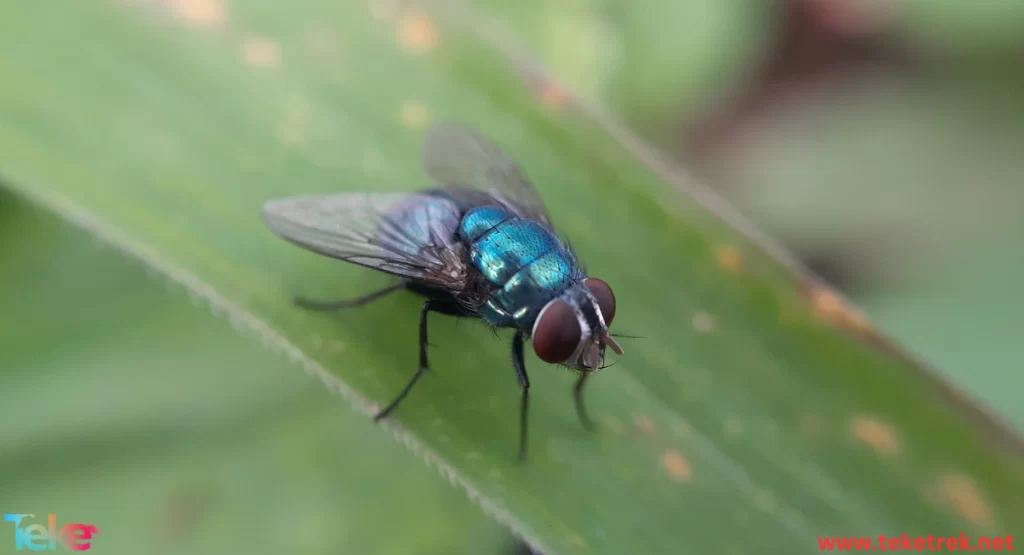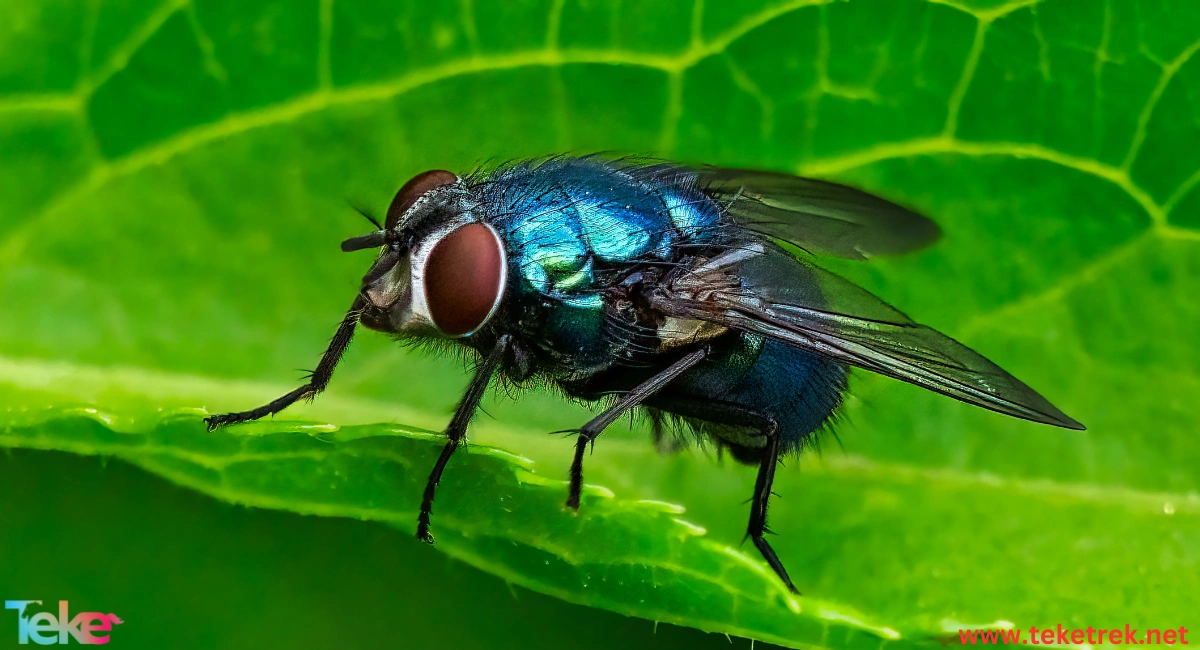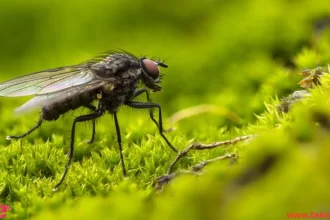Blue flies are one of the annoying types of insects that can cause various pests that spread throughout the world.
Below, on the TekeTrek website, we discuss the characteristics and features of blue flies and the most important information and facts about them.

About blue flies
- The blue fly is characterized by its striking color and is sometimes called the bloated fly or blue bottles.
- These insects are attracted to garbage, rotting animal carcasses, and open animal wounds.
- The blue fly belongs to the Calliphoridae family, the Arthropoda phylum, from the class of mammals.
- It resembles the common housefly but is distinguished by its blue body color.
- The blue fly appears with a large head, bulging eyes, and has a metallic appearance.
- The blue fly has feeding and breeding habits similar to the housefly.
- The blue fly tends to be slightly larger than the regular housefly and emits a loud sound. Adults can sometimes be seen gathering on window and door barriers.
- Contact your local pest control specialist to discuss custom treatments and extermination methods for your home.
- The blue fly does not bite humans but feeds on decomposing materials, wet garbage, spoiled food, and decaying meat remnants. This species thrives best in warm and humid environments.
- To eliminate the bottle fly, it is important to implement strict sanitary measures, which include cleaning garbage containers and ensuring that lids are tightly fitted.
Blue fly habitats
The blue fly can be found in yards, restaurant waste areas, and garbage dumps.
It can also be found inside homes when there are small dead animals such as mice or birds.
This fly is more than just a nuisance as it has been proven to transmit diseases.
Types of blue flies
Blue flies are a part of the blowfly family, known for their metallic blue or green coloration. There are several species of blue flies, and they can differ in appearance and behavior. Here are some of the most common types:
1. Common Bluebottle Fly (Calliphora vomitoria)
- Appearance: Metallic blue with shiny, smooth bodies.
- Habitat: Commonly found near decomposing organic matter, such as dead animals or rotting food.
- Behavior: Known for being attracted to decaying meat, and they lay their eggs in carcasses, which hatch into larvae (maggots).
2. Greenbottle Fly (Lucilia sericata)
- Appearance: Although it’s typically green, it can also have a bluish sheen.
- Habitat: Found around garbage, rotting food, and animal carcasses.
- Behavior: Similar to the bluebottle fly, they are attracted to decaying organic matter and are often involved in the decomposition process.
3. Bronze Greenbottle Fly (Lucilia caesar)
- Appearance: A metallic green with a bronze tint, sometimes reflecting blue.
- Habitat: Commonly found around dead animals, waste, and rotting food.
- Behavior: Like other blowflies, they lay eggs on decaying matter, and the larvae feed on the organic material.
4. Tachina Fly (Tachina spp.)
- Appearance: Often metallic blue, though they can also have a more varied coloration with some green or bronze.
- Habitat: These flies are parasitic and typically found on other insects, such as caterpillars or grasshoppers.
- Behavior: Tachina flies are parasitoids, meaning they lay their eggs on other insects, and the larvae eventually consume their hosts.
5. Chrysomya species (e.g., Chrysomya megacephala)
- Appearance: This species can have a blue or greenish tint and is often confused with the greenbottle fly.
- Habitat: Common in tropical and subtropical regions, they are often found on decaying animal matter.
- Behavior: Known to be attracted to carrion and are important in forensic entomology for determining the time of death in criminal investigations.
6. European Bluebottle Fly (Calliphora livida)
- Appearance: Similar to Calliphora vomitoria, but slightly smaller and with a different pattern of coloration.
- Habitat: Found in Europe and also attracted to decaying organic matter.
- Behavior: This fly also lays its eggs in decomposing bodies, and its larvae play a role in decomposition.
These are just a few examples of the various types of blue flies, but the main feature that unites them is their attraction to decaying organic material. Blue flies are often crucial in decomposition processes, but they can also be a nuisance and a health concern due to the diseases they may spread.
Blue Fly Diet: What Do They Eat?
Among the many other types of decomposing organic matter, the following serve as a food source for the insects and breeding ground:
- Decomposing animal flesh.
- Feces.
- Garbage.
- Spoiled meats.
Blue fly breeding stages
- A female bottle fly can lay more than 2000 eggs throughout her life, and the eggs are pale yellow or gray in color.
- The resulting larvae range from 9 to 22 mm in length and may hatch within two to three days, depending on the temperature.
- Within two to ten days, the larvae search for pupation sites, from which they eventually emerge as adult flies.
- The blue fly reproduces in wet organic materials such as dead animals.
Blue fly life cycle
A female blue fly lays up to 150-200 eggs in each batch. From egg laying to hatching, the entire process takes about one day.
- Larva – Stage One:
The larvae feed on body fluids, and this stage takes about one day to complete.
- Larva – Stage Two:
In this stage, the larvae wander in worm form, and the transition from the first stage to this stage takes about one day.
- Larva – Stage Three:
The larvae still wander in large numbers, but their size increases significantly in this stage. It is the pre-pupa stage, and it takes about two days to reach it.
- Pre-pupation stage:
In this stage, they move away from the body they were feeding on to a suitable pupation site, generally the soil, and turn into a pupa.
It takes about four days to go from the pre-pupation stage to the pupa state.

Pupae:
The pupae continue to stay at the pupation site and turn into adult flies. This development from pupa to adult fly takes about ten days to complete. Until this stage, since they moved to the pupation site, they do not feed.
Adult fly
The adult fly mates upon emerging from the pupa, feeds on body fluid proteins, and lays its eggs on the corpse. It takes about two days for the adult fly to emerge to lay eggs.
Distinctive physical blue fly characteristics
- The main feeding stage of the fly is the larval stage.
- After hatching, the larva is about 2 mm long and grows to about 5 mm before shedding its skin to enter the second stage.
- The larva is about 10 mm long before shedding its skin to enter the third stage, where it grows to about 15 mm – 20 mm before reaching the pre-pupa stage.
- There is no significant difference in the general appearance of the fly larva in the different stages.
Information about blue fly larvae
- The fly larva is an eating machine, as the larva has mouth hooks at the front end, which it uses to feed on the torn decomposing flesh from the corpse.
- The anal opening and the posterior respiratory openings are located in the chamber at the rear end. These openings help the larva breathe.
- The larva has a muscular and segmented body that helps it easily flip over the corpse, in addition to having simple intestines and a pair of large salivary glands that help it secrete digestive enzymes and spread rotting bacteria, creating a soup-like environment.
- The larvae wander in large numbers, and also the intense nature of their digestive activities generates tremendous heat, so the body near the environment may be exposed to high temperatures that sometimes reach 53 degrees Celsius.
- Sometimes intense heat is generated inside the mass, prompting the larvae in the center to move to the edges to cool down. This heat increases the rate of digestion and decay.
The Role of Blue Flies in Medicine
Blue fly larvae are widely used in forensic investigations to estimate the time of death. Scientists rely on their life cycle to determine the time elapsed since death with high accuracy. When a body is exposed to open air, blue flies are among the first insects to arrive and lay eggs on moist tissues. These larvae develop at measurable rates based on temperature and environmental conditions. By analyzing their growth stages, forensic experts can determine the post-mortem interval, making blue flies an essential tool in forensic science.
In addition to their forensic significance, blue fly larvae are also used in medical treatments for chronic wounds and ulcers in a process known as “maggot therapy.” These larvae feed on dead tissue while leaving healthy tissue intact, effectively cleaning wounds and preventing infections. Studies have shown that this method accelerates the healing process, particularly in diabetic foot ulcers and pressure sores, reducing the need for surgical intervention.
Blue Flies vs. Houseflies: Key Differences
Blue flies stand out from other fly species due to their metallic blue and green appearance, which makes them easily distinguishable from common houseflies. They are also relatively larger and more active when searching for decomposing organic matter to lay their eggs. While blue flies are primarily attracted to carrion and decaying matter, houseflies are more commonly found near food waste and human dwellings.
Their life cycle also differs from that of other fly species, as they develop more rapidly under optimal conditions. The blue fly’s cycle begins with egg-laying, followed by the larval stage, then pupation before emerging as an adult. This accelerated growth and specific behavior make blue flies particularly useful in forensic science, unlike houseflies, which are more associated with disease transmission.
Impact of Blue Flies on Human Health
Although blue flies do not bite humans, they can be potential vectors of pathogens. Because they feed on carcasses and decomposing organic matter, they can carry bacteria and viruses to surfaces and food. This contamination can lead to the spread of diseases such as food poisoning and gastrointestinal infections, making blue flies a concern for public health.
Recent studies have also suggested that blue flies may play a role in transmitting avian influenza viruses. Research indicates that flies can carry the virus externally or internally, posing a risk to poultry farms and overall health safety. Therefore, controlling the spread of blue flies in both urban and agricultural settings is crucial to minimizing their health risks.
Blue Flies in Popular Culture and Folklore
Blue flies hold a unique place in folklore and cultural beliefs, often being associated with “wandering spirits of the dead” in various traditions. In some communities, their presence around homes or abandoned areas is considered an omen or linked to supernatural forces. They have also been used in literature and idioms, such as the popular saying, “Not even the blue fly will find its way,” which signifies the impossibility of finding a missing person.
In arts and literature, blue flies have often symbolized decay and transformation. They appear in paintings and poetry as metaphors for mortality, while in crime fiction, their presence is used as a clue to indicate the time and place of a crime scene.
The Role of Blue Flies in Environmental Balance
Beyond their association with decay, blue flies play an essential role in maintaining ecological balance. They contribute to the decomposition of organic matter, speeding up nutrient recycling and soil enrichment. Additionally, some plants rely on insects attracted to strong odors, including blue flies, for pollination. This interaction promotes biodiversity and helps sustain specific plant species in their habitats.
Effective Ways to Control Blue flies in house
To prevent blue fly infestations, it is essential to take proactive measures, such as promptly disposing of waste, covering food, and installing window screens to keep flies out. Light traps and baited fly traps can help reduce their numbers, while maintaining cleanliness in damp and dark areas minimizes their breeding opportunities. By implementing these preventive strategies, homeowners can effectively manage and reduce blue fly populations indoors.
Frequently asked questions about the blue fly
- Why do I have bluebottles in my house?
The blue fly is found all over the world and is present almost everywhere humans live. It is one of the most common flies found around dead animals and is often discovered near meat processing plants and garbage dumps.
The blue fly can enter homes through any gaps and openings, but it usually does not enter the home unless there is a food source.
Finding Blue flies in house is usually an indicator of another dead pest or nearby rodents.
- How long does the bloated fly live?
The life cycle of the blowfly is short and lasts about 3-4 weeks.
The egg incubation period ranges from 4 to 5 days, and larval development is completed within 4 to 10 days.
- Are blue flies harmful?
Flies do not bite humans, however, they can pose serious health threats to humans and animals. The worms can infect living animals, leading to a parasitic condition known as myiasis.
- What are the harms of blue flies?
It was also found that blue flies, known as carrion flies, are wingless and house flies, are more exposed to unhealthy materials, because they depend on feces, carrion, and decaying organic materials to feed on them, and they can then pick up bacteria that can be a major cause of disease for humans. And plants and animals.
- What kills blue flies?
Blue flies, like other flies, can be killed by various methods, including:
- Insecticides: Common fly sprays or insecticides are effective in killing blue flies.
- Fly traps: Special traps that use attractants like food or light can catch and kill blue flies.
- Natural predators: Certain insects, such as spiders, ants, and other fly-eating animals, can reduce blue fly populations.
- Environmental conditions: Extreme heat or cold can also be lethal to blue flies if exposed for long periods.
- Is a blue fly rare?
Blue flies (often referring to Calliphora vomitoria or similar species) are not particularly rare. They are commonly found in many parts of the world, especially in areas with decomposing organic material. They are part of the blowfly family, which includes a variety of species, and are often seen around garbage, decaying food, or animal carcasses.
- Are blue flies dangerous?
Blue flies are not typically dangerous in the sense of biting or directly harming humans. However, they can be a health concern in some cases:
- Disease transmission: Blue flies are known to carry bacteria and other pathogens on their bodies, which they pick up when feeding on decaying matter. If they land on food or surfaces, they can potentially transfer harmful bacteria to humans.
- Food contamination: Because of their habits of feeding on waste, they can contaminate food, posing a risk to hygiene.
In summary, studying the blue fly insect highlights the importance of understanding the environment and human impact on it. Its presence reflects the state and health of the environment. Its presence should be used as an environmental indicator to detect health or environmental issues. We need to maintain environmental balance and biological diversity by taking protective and enhancing actions for the environment for the benefit of all forms of life.






